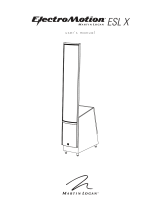
6
amplification directly connected to the high- and
low-frequency sections of the crossover. There are
two different methods for bi-amping with two stereo
amplifiers. The first and most common is referred
to as Horizontal Bi-amping. The second method is
referred to as Vertical Bi-amping. With either meth-
od you may use two stereo amplifiers or four mono
amplifiers, or two mono amplifiers and one stereo
amplifier. Get the idea? With either form of passive
bi-amplification, your preamplifier must have dual
outputs. If your preamplifier is not so equipped, you
must either purchase or construct a “Y” adapter.
Horizontal Passive Bi-Amplification
Horizontal bi-amping allows you to use two differ-
ent types, models or brands of amplifiers (i.e. tubes
on top, transistor on the bottom). However, we
recommend that you use two identical amplifiers
(i.e. same brand and model). If you must use two
different amplifiers, it is essential that they have the
same gain or that one of the two have adjustable
gain so that you can match their gain character-
istics. If the amplifiers of choice do not have the
same gain characteristics, then a sonic imbalance
will occur. With horizontal bi-amping, one ampli-
fier drives the high-frequency section of the speaker
while the second amplifier drives the low-frequency
section. To horizontally bi-amp your speakers you
must loosen the binding posts and remove the
jumper clips. Connect the low-frequency amplifier
to the lower set of binding posts of both speakers.
Connect the high-frequency amplifier to the upper
set of binding posts. Next, connect the left and
right preamplifier outputs to the appropriate left
and right inputs of both amplifiers (Fig. 3).
Vertical Passive Bi-Amplification
The very nature of vertical bi-amping dictates that
both amplifiers be identical. With vertical bi-amp-
ing, each of the stereo amplifiers is dedicated to
one speaker. For instance, the left channel of each
amplifier drives the low-frequency section while the
right channel drives the high-frequency section. To
vertically bi-amp your speakers you must loosen the
binding posts and remove the jumper clips from
both speakers. Starting with one speaker, connect
the right channel to the lower binding posts and
the left channel to the upper binding posts. Repeat
the same procedure for the other speaker. Connect
the left preamplifier outputs to both inputs of the left
channel amplifier and the right preamplifier outputs
to both inputs of the right channel amplifier (Fig.
4).
ACTIVE BI-AMPLIFICATION
We do not recommend active bi-amplification.
The internal crossover can not be bypassed. This
connection method seriously degrades perfor-
mance.


















